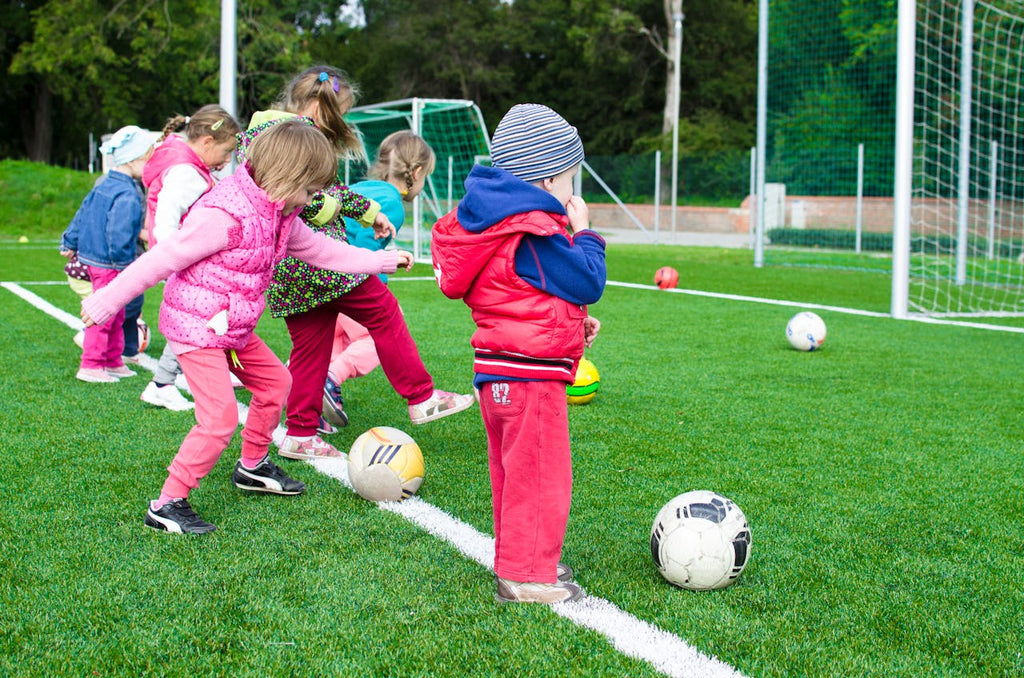How to Ensure Your Children Get Enough Exercise for a Healthy Lifestyle
Wanna be friends with benefits? Join 2000+ who already are.
Click here to subscribe!

In today's digital age, where screens dominate much of our time and sedentary lifestyles are becoming more common, ensuring that children lead active lives has never been more crucial — and exercise lays the foundation for a lifetime of health and well-being.
Beyond building stronger muscles and bones, physical activity in children can enhance sleep quality, improve concentration, and boost confidence. With this guide I aim to assist parents and caregivers in integrating effective strategies to ensure their children get the necessary exercise for a vibrant, healthy lifestyle. Through practical tips and understanding the importance of leading by example, we can pave the way for our children to adopt and maintain active habits that will benefit them throughout their lives.
Age-Appropriate Activities
Finding age-appropriate activities can significantly impact how children perceive exercise, turning it into a delightful part of their daily routine rather than a chore. For younger children, activities such as playing tag, riding bikes, or participating in toddler gymnastics classes foster motor skills, balance, and coordination. School-aged children may enjoy more structured activities such as soccer, where community leagues provide the opportunity to develop teamwork and social skills. If you are from the area, you can play soccer in Massachusetts and foster your child's love for the sport. As children enter their teenage years, activities like dancing, martial arts, and strength training can become more enticing.
Encouraging children to try a variety of activities helps them discover what they enjoy most, promoting a lifelong engagement with exercise. Most importantly, this variety ensures that exercise remains engaging, challenging, and fun, key components in building a healthy lifestyle.
Daily Exercise Guidelines
The American Academy of Pediatrics recommends children engage in at least 60 minutes of moderate to vigorous physical activity daily. This guideline serves as a compass for parents navigating their child's physical activity needs.
Activities can range from structured sports to free play outdoors, each with its unique benefits. For instance, free play encourages creativity and independence while structured activities teach discipline and teamwork. Combining different types of exercise can help children develop a diverse set of skills that will serve them well in all aspects of their lives.
Variety is Key
When you blend activities that focus on endurance, strength, flexibility, and balance, parents can help their children build a holistic fitness foundation. For instance, swimming and cycling are excellent for building endurance while yoga and gymnastics improve flexibility and balance. Not to mention, rock climbing or playground activities can enhance strength and agility.
Parents can also leverage technology, such as fitness video games or apps that encourage physical movement, making exercise both accessible and engaging. This multipronged approach caters to the diverse interests of children and prepares their bodies and minds to face varied life challenges with resilience. No matter the activity, incorporating a mix of exercises promotes a well-rounded and healthy lifestyle.
Incorporating Technology
With the advent of technology, it's easy to think that our kids are glued to their screens for hours on end. But what if we told you that technology could actually encourage physical activity and outdoor play? Believe it or not, there are apps and games out there that can get your child moving and exploring the great outdoors.
Maybe your child loves to explore the outdoors but needs a little extra motivation. Apps like Geocaching or Pokemon Go can add an element of adventure and exploration to their outdoor time. Or, if your child is more interested in fitness and competition, there are various fitness video games that incorporate fun exercises such as dancing or virtual sports. Through the incorporation of technology, we can make exercise more accessible and appealing to our children.
Family Involvement
When children see their parents or caregivers actively participating in exercise, they are more likely to view physical activity as a positive and integral part of daily life. Engaging in family walks, bike rides, or even playful competitions in the backyard serves as quality bonding time that reinforces the idea that exercise is enjoyable.
This shared experience can also create lasting memories and traditions that encourage a persistent commitment to health and wellness. Families need to communicate openly about the joys and challenges of maintaining an active lifestyle, fostering an environment where physical health is prioritized and celebrated. Parents can also involve children in the decision-making process, allowing them to choose activities or set goals that align with their interests and abilities.
Limiting Screen Time
While technology can be a helpful tool in promoting physical activity, it's essential to balance screen time with other forms of exercise. Setting limits on screen time and encouraging children to engage in other activities can reduce sedentary behaviors and promote a more active lifestyle.
Parents can set boundaries by limiting screen time to specific hours or incorporating screen-free days into the family's schedule. They can also encourage alternative forms of entertainment, such as reading, puzzles, or board games, that foster cognitive development and creativity while keeping children physically active. Even household chores and errands can provide opportunities for movement and physical activity.
Encouragement Over Pressure
The art of fostering a healthy relationship between children and exercise lies in encouragement rather than pressure. Positive reinforcement and celebrating small achievements can significantly motivate children to stay active and enjoy physical activities. Parents need to recognize that each child has unique preferences and abilities; understanding this allows for the personalization of physical activities that align with their interests.
Further, involving children in setting achievable fitness goals or choosing new activities to try can empower them, giving them a sense of ownership over their physical health. When children feel supported and understood in their fitness journeys, they are more likely to develop a lifelong love for staying active. The goal is to instill a love for movement that extends well beyond childhood, fostering a foundation of health and wellness that they can build upon throughout their lives.
Community Resources
Many communities offer youth sports leagues, swimming pools, parks, and recreational centers that are either free or have a minimal cost. These resources give children the opportunity to be active and socialize and build friendships with peers outside their usual social circle.
Community events such as fun runs, charity walks, or sports tournaments can introduce children to the joy of being active while contributing to a cause, teaching them the value of community and teamwork. Parents seeking to enrich their children's physical activity options should explore local community boards, school bulletins, and social media groups dedicated to family and recreational activities. Once you've identified activities or resources that align with your child's interests, encourage them to participate and support their involvement in the community.
Outdoor Time
Maximizing outdoor time is a simple yet effective strategy for ensuring children get enough exercise. The natural world offers an extensive playground that encourages physical movement, exploration, and adventure. Outdoor activities like walking in the park, hiking through trails, or simply playing in a backyard expose children to fresh air and natural light, which are essential for healthy growth and development.
Such experiences can significantly enhance their observational skills, appreciation for nature, and environmental awareness. Outdoor play also gives children the opportunity to unplug from technology and engage in physical activities that promote creativity, cooperation, and self-esteem.

Safety First
While nurturing an active lifestyle for children, you don't want to forget about the safety aspect of physical activities. When engaging in outdoor or organized sports, it's crucial to ensure your child has the right protective gear and follows proper safety guidelines. For instance, wearing a helmet while cycling or knee pads during roller skating can prevent injuries and promote safe play.
As a parent, you should stay informed about weather conditions and environmental hazards that may pose risks to your children's well-being. You can also educate your children about basic safety precautions, such as staying hydrated, warming up before physical activities, and dressing appropriately for the weather. By prioritizing safety, parents can provide a secure environment for their children to enjoy physical activities and develop healthy habits.
The Role of Play
Play is not just a way for children to spend energy; it's a crucial aspect of their development, facilitating learning and fostering social connections. It enables children to explore their interests, stimulate imagination, and develop physical, cognitive, and emotional strengths. Encouraging play, be it outdoors in nature or indoors with building blocks, allows children to take risks in a controlled environment, learn from their mistakes, and build resilience.
Playtime provides an excellent opportunity for parents to engage with their children, strengthening bonds and understanding their unique personalities. Parents can also use playtime as a way to introduce new activities or games, making exercise an enjoyable and meaningful part of their child's routine.
Ensure Your Children Get Enough Exercise for a Healthy Lifestyle
Instilling a love for physical activity in children is one of the most valuable gifts parents and caregivers can provide. It lays the foundation for a healthy, vibrant lifestyle that benefits the mind, body, and spirit. By emphasizing fun, variety, and the importance of family involvement, we can inspire our children to adopt and maintain active habits that will serve them well throughout their lives.
Engaging in physical activity should not be seen merely as a task but as an enjoyable and rewarding part of every day. Through encouragement, leading by example, and leveraging community resources, we can support our children in discovering the joy and benefits of staying active. Doing so will not only benefit our children's physical health but also promote overall well-being and happiness. Let's work together to raise a generation that values and prioritizes an active lifestyle.